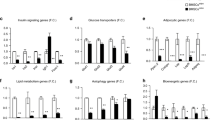Abstract
In the present study, we examined the effect of palmitate on adipocyte differentiation in mouse bone marrow-derived mesenchymal stem cells (MSCs). Obesity is associated with increased adipocyte differentiation of preadipocytes or MSCs. Free fatty acids (FFAs) have been reported to have an influence on adipogenesis. Thus, the elevated level of FFAs in obese individuals may set off a vicious cycle of events leading to further increased adipogenesis. Palmitate is one of the most abundant FFAs in plasma. The results in this study showed that treatment with palmitate for 3 days, followed by maintenance with insulin for 4 days (palmitate 3d/insulin 4d), induced lipid accumulation and adipocyte protein 2 (aP2) expression in bone marrow-derived MSCs. Our results also showed that treatment with palmitate 3d/insulin 4d induced expressions of adipogenic transcription factors, namely CCAAT enhancer-binding protein (C/EBP) β, C/EBPα, and PPARΓ in bone marrow-derived MSCs. In comparison of palmitate with stearate, the levels of lipid accumulation, aP2, and adipogenic transcription factors in cells treated with palmitate 3d/insulin 4d were generally higher than those of cells treated with same concentration of stearate 3d/insulin 4d. Taken together, our results suggest that palmitate is a potent adipogenic FFA that triggers adipocyte differentiation of bone marrow-derived MSCs.
Similar content being viewed by others
References
KM Flegal, MD Carroll, CL Ogden, et al., Prevalence and trends in obesity among US adults, 1999–2008, JAMA, 303, 235 (2010).
PG Kopelman, Obesity as a medical problem, Nature, 404, 635 (2000).
E Manickam, AJ Sinclair, D Cameron-Smith, Suppressive actions of eicosapentaenoic acid on lipid droplet formation in 3T3-L1 adipocytes, Lipids Health Dis, 9, 57 (2010).
W Guo, S Wong, W **e, et al., Palmitate modulates intracellular signaling, induces endoplasmic reticulum stress, and causes apoptosis in mouse 3T3-L1 and rat primary preadipocytes, Am J Physiol Endocrinol Metab, 293, E576 (2007).
JT Crossno, Jr., SM Majka, T Grazia, et al., Rosiglitazone promotes development of a novel adipocyte population from bone marrow-derived circulating progenitor cells, J Clin Invest, 116, 3220 (2006).
A Alhadlaq, M Tang, JJ Mao, Engineered adipose tissue from human mesenchymal stem cells maintains predefined shape and dimension: implications in soft tissue augmentation and reconstruction, Tissue Eng, 11, 556 (2005).
M Vallee, JF Cote, J Fradette, Adipose-tissue engineering: taking advantage of the properties of human adipose-derived stem/stromal cells, Pathol Biol (Paris), 57, 309 (2009).
Commision on biochemical nomenclature, the nomenclature of lipids, Eur J Biochem, 79, 11 (1977).
SW Coppack, MD Jensen, JM Miles, In vivo regulation of lipolysis in humans, J Lipid Res, 35, 177 (1994).
G Boden, GI Shulman, Free fatty acids in obesity and type 2 diabetes: defining their role in the development of insulin resistance and beta-cell dysfunction, Eur J Clin Invest, 32Suppl 3, 14 (2002).
HO Steinberg, M Tarshoby, R Monestel, et al., Elevated circulating free fatty acid levels impair endothelium-dependent vasodilation, J Clin Invest, 100, 1230 (1997).
YH Hong, Y Nishimura, D Hishikawa, et al., Acetate and propionate short chain fatty acids stimulate adipogenesis via GPCR43, Endocrinology, 146, 5092 (2005).
JY Yang, MA Della-Fera, S Rayalam, et al., Regulation of adipogenesis by medium-chain fatty acids in the absence of hormonal cocktail, J Nutr Biochem, 20, 537 (2009).
SW Qian, X Li, YY Zhang, et al., Characterization of adipocyte differentiation from human mesenchymal stem cells in bone marrow, BMC Dev Biol, 10, 47 (2010).
GM Reaven, C Hollenbeck, CY Jeng, et al., Measurement of plasma glucose, free fatty acid, lactate, and insulin for 24 h in patients with NIDDM, Diabetes, 37, 1020 (1988).
GV Richieri, AM Kleinfeld, Unbound free fatty acid levels in human serum, J Lipid Res, 36, 229 (1995).
Author information
Authors and Affiliations
Corresponding authors
Rights and permissions
About this article
Cite this article
Park, E.Y., Yeum, C.E., Seo, G. et al. The adipogenic effect of palmitate in mouse bone marrow-derived mesenchymal stem cells. Tissue Eng Regen Med 10, 77–85 (2013). https://doi.org/10.1007/s13770-013-0005-4
Received:
Revised:
Accepted:
Published:
Issue Date:
DOI: https://doi.org/10.1007/s13770-013-0005-4




